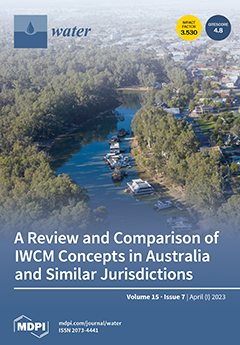Water treatment alternatives such as adsorption using agricultural residues are currently being studied to eliminate pollutants that cause eutrophication in water bodies, avoiding the alteration of aquatic ecosystems. In this work, two bio-adsorbents were prepared using cellulose extracted from corn stems,
Zea mays
[...] Read more.
Water treatment alternatives such as adsorption using agricultural residues are currently being studied to eliminate pollutants that cause eutrophication in water bodies, avoiding the alteration of aquatic ecosystems. In this work, two bio-adsorbents were prepared using cellulose extracted from corn stems,
Zea mays, which were labeled as
MC (quaternized cellulose modified with Cetyl trimethyl ammonium chloride) and
B 1:1 (biochar obtained by the impregnation of the biomass with an H
2SO
4 solution, 50%
v/
v, using a ratio of 1:1% weight of biomass to volume, followed by carbonization at 520 °C for 30 min with a heating rate of 10 °C/min). FTIR, TGA, DSC, and SEM-EDS were used to study the properties of the bio-adsorbents. The effect of temperature over nitrate and phosphate adsorption in the selective and binary system at 100 mg/L was tested at five temperatures: 25, 30, 35, 40, and 45 °C, using a load of the pollutant of 100 mg/L, volume of 5 mL, and a rate of bio-adsorbent of 2 g/L at 200 rpm. Results showed a phosphate removal of 29.1% using the
B 1:1 bio-adsorbent at 30 °C and 23.8% with the
MC bio-adsorbent at 35 °C. In the case of nitrate, removal of 40% was determined with the
B 1:1 bio-adsorbent at 25 °C, while removal of 38.5% was attained at 30 °C after using the
MC bio-adsorbent. The equilibrium was reached at 420 min. Nitrate adsorption with the
MC sample showed a good adjustment to the pseudo-second-order model. The pseudo-first-order model described the kinetics of phosphate removal with
MC, while this model had a good fit with the
B 1:1 sample for nitrate and phosphate. Freundlich’s model also adjusted the adsorption equilibrium for both anions with acceptable accuracy. Moreover, the binary study indicated selectivity for the phosphate, suggesting the potential applications of the carbon-based bio-adsorbents for anionic ions remotion in aqueous media.
Full article





